 The United Religious, Military and Masonic Orders of the Temple and of St John of Jerusalem, Palestine, Rhodes and Malta in England and Wales and Provinces Overseas
The United Religious, Military and Masonic Orders of the Temple and of St John of Jerusalem, Palestine, Rhodes and Malta in England and Wales and Provinces Overseas
Province of Kent
 Famous Knight Templars
Famous Knight Templars
Hugues de Payens
Hugues de Payens was the first Grand Master of the Knights Templar. Served from c.1119 to 1136. Hugues was related to the Counts of Champagne. His family and feudal ties assured that the Knights Templar gained support of upper nobility and influential clergymen such as Bernard de Clairvaux. After the incorporation of the Knights Templar, Hugues de Payns personally traveled to the West seeking support for the newly formed Order.
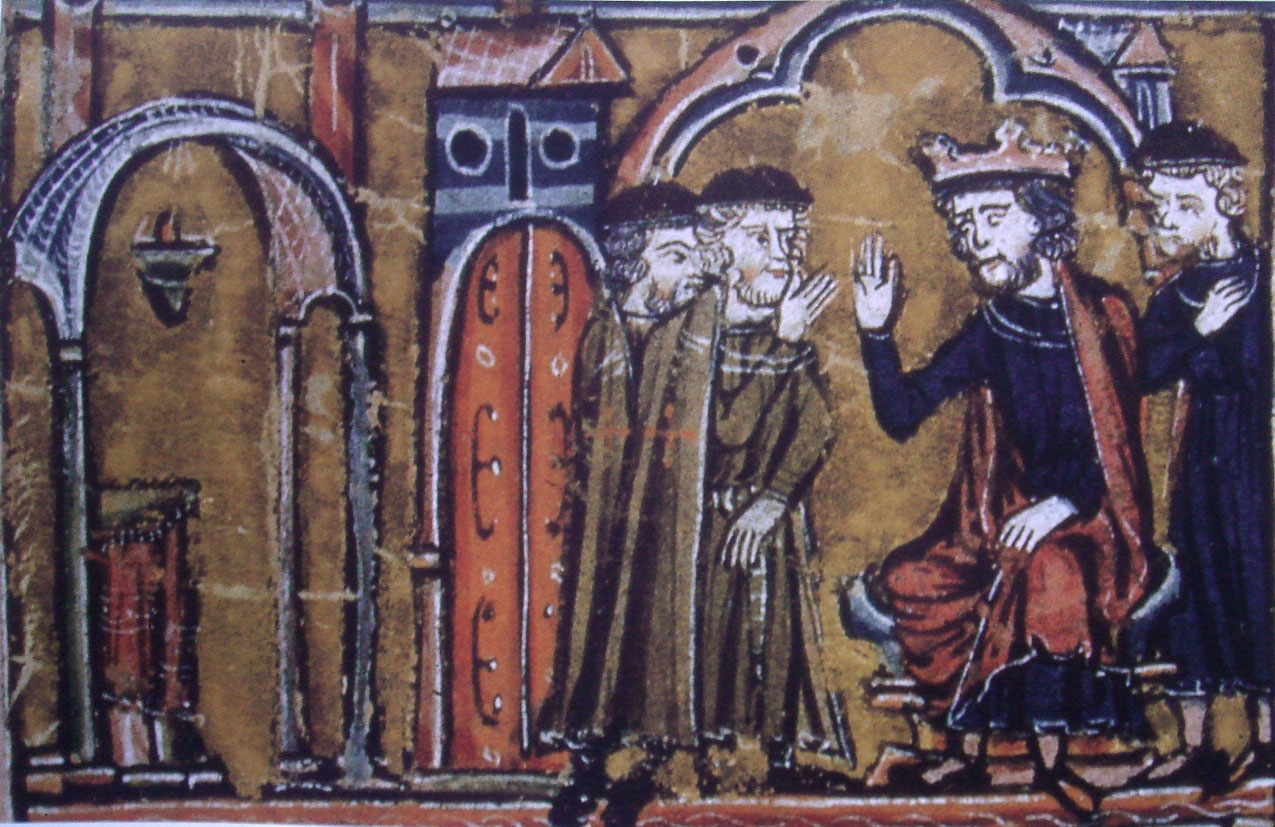 Baldwin II ceeding the location of the Temple of Salomon to Hugues de Payns and Gaudefroy de Saint-Homer. The fourth person is Warmund, Patriarch of Jerusalem.
Baldwin II ceeding the location of the Temple of Salomon to Hugues de Payns and Gaudefroy de Saint-Homer. The fourth person is Warmund, Patriarch of Jerusalem.
Hugues de Payens was the first Grand Master of the Knights Templar. Served from c.1119 to 1136. Hugues was related to the Counts of Champagne. His family and feudal ties assured that the Knights Templar gained support of upper nobility and influential clergymen such as Bernard de Clairvaux. After the incorporation of the Knights Templar, Hugues de Payns personally traveled to the West seeking support for the newly formed Order.
 Baldwin II ceeding the location of the Temple of Salomon to Hugues de Payns and Gaudefroy de Saint-Homer. The fourth person is Warmund, Patriarch of Jerusalem.
Baldwin II ceeding the location of the Temple of Salomon to Hugues de Payns and Gaudefroy de Saint-Homer. The fourth person is Warmund, Patriarch of Jerusalem.Godfroi de St Omer
Godfroi de St Omer was considered one of the two principal founders of the Knights Templar, along with Hugues de Payens. Most likely descendant of the St Omer family in Picardy.
Godfroi de St Omer was considered one of the two principal founders of the Knights Templar, along with Hugues de Payens. Most likely descendant of the St Omer family in Picardy.
Gerard de Ridefort
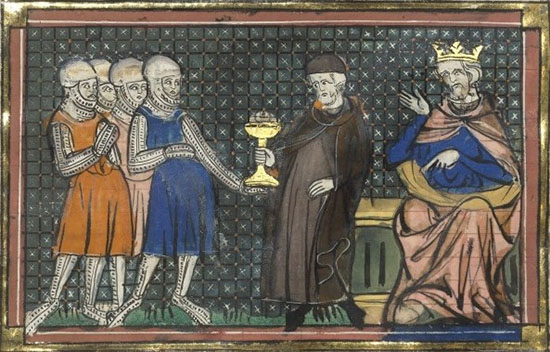 Gérard de Ridefort hiring troops
Gerard de Ridefort was the tenth Grand Master of the Knights Templar (1185 – 1189). Most likely of Flemish roots, Gerard de Ridefort was known for his impetuous temper. Although he clearly possessed personal bravery, his rash decisions led to one of the worst defeats of the Christian forces in Outremer in the battle of Hattin. De Ridefort himself was captured, but unlike the other Templars he was held for ransom and later released. He died during the siege of Acre in 1189.
Gérard de Ridefort hiring troops
Gerard de Ridefort was the tenth Grand Master of the Knights Templar (1185 – 1189). Most likely of Flemish roots, Gerard de Ridefort was known for his impetuous temper. Although he clearly possessed personal bravery, his rash decisions led to one of the worst defeats of the Christian forces in Outremer in the battle of Hattin. De Ridefort himself was captured, but unlike the other Templars he was held for ransom and later released. He died during the siege of Acre in 1189.

 Gérard de Ridefort hiring troops
Gérard de Ridefort hiring troopsGuillaume de Beaujeau
The 20th Grand Master of the Knights Templar (1273-1291). Guillaume bravely fought and died during the siege of Acre in 1291. Legend has it, de Beaujeau threw his sword down and proceeded to walk away from the front lines. When questioned as to why he was fleeing, the Grand Master replied, “I am not fleeing. I am dead.” De Beaujeau’s death sealed the fate of the city. Acre was lost to the Crusaders forever.
The 20th Grand Master of the Knights Templar (1273-1291). Guillaume bravely fought and died during the siege of Acre in 1291. Legend has it, de Beaujeau threw his sword down and proceeded to walk away from the front lines. When questioned as to why he was fleeing, the Grand Master replied, “I am not fleeing. I am dead.” De Beaujeau’s death sealed the fate of the city. Acre was lost to the Crusaders forever.
Roger de Flor
Roger de Flor (1266-1306) was probably the most famous Templar who was a sergeant-brother, not a knight. Roger de Flor (also known by his original German name of Rutger von Blume) was a captain in the Templar fleet. After he got banished from the Order on charges of extorting money from passengers during the siege of Acre in 1291, Roger sought employment around the Mediterranean, eventually becoming a pirate. De Flor’s assassination was ordered by the Byzantine Emperor Michael IX Palaeologus.
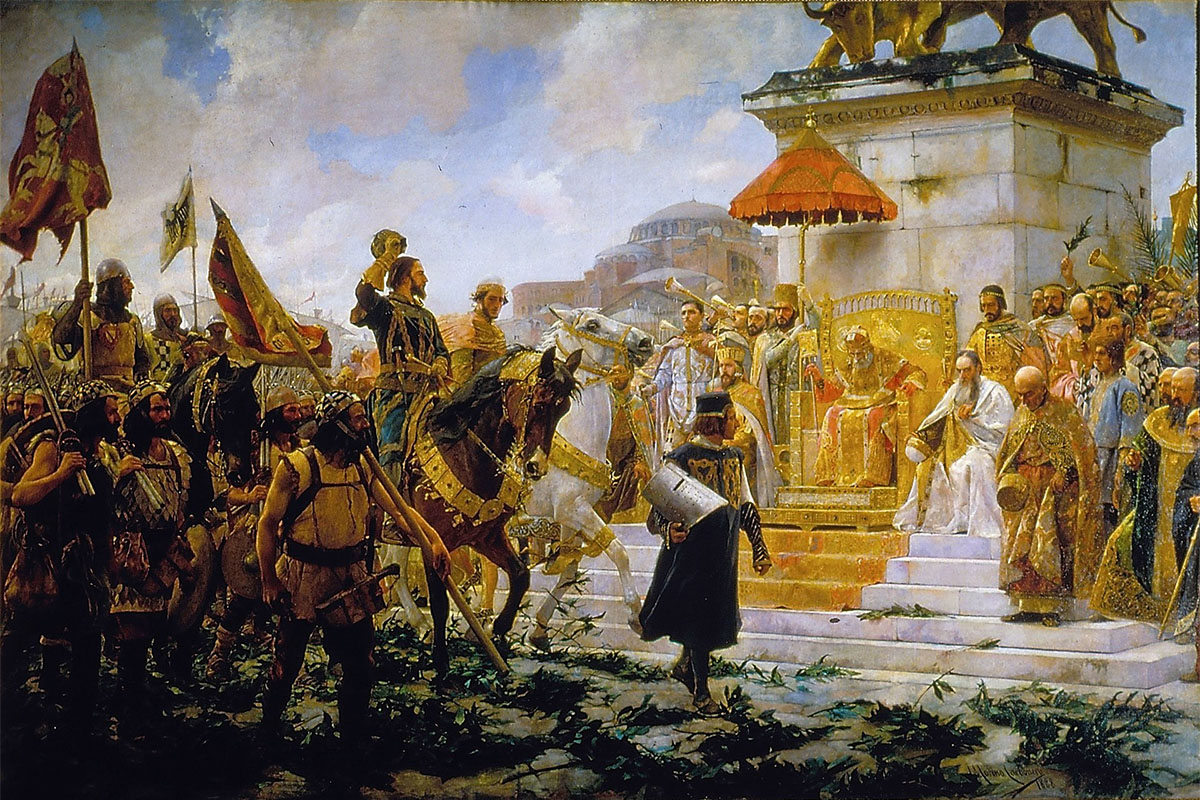 Entry of Roger de Flor in Constantinople by José Moreno Carbonero
Entry of Roger de Flor in Constantinople by José Moreno Carbonero
Roger de Flor (1266-1306) was probably the most famous Templar who was a sergeant-brother, not a knight. Roger de Flor (also known by his original German name of Rutger von Blume) was a captain in the Templar fleet. After he got banished from the Order on charges of extorting money from passengers during the siege of Acre in 1291, Roger sought employment around the Mediterranean, eventually becoming a pirate. De Flor’s assassination was ordered by the Byzantine Emperor Michael IX Palaeologus.
 Entry of Roger de Flor in Constantinople by José Moreno Carbonero
Entry of Roger de Flor in Constantinople by José Moreno CarboneroGeoffroi de Charney
At the height of his career Geoffroi de Charney (1252 – 18 March 1314) held an important position of the Preceptor of Normandy. He was burned at the stake in Paris alongside Jacques de Molay, as both proclaimed the Order’s innocence. It is presumed that de Charney family remained in possession of the most cherished Templar relic which was later revealed to the public by a French knight named Geoffroi de Charny in the 1350s. Today this relic is known as the Shroud of Turin.
 Full-length image of the Turin Shroud before the 2002 restoration.
Full-length image of the Turin Shroud before the 2002 restoration.
At the height of his career Geoffroi de Charney (1252 – 18 March 1314) held an important position of the Preceptor of Normandy. He was burned at the stake in Paris alongside Jacques de Molay, as both proclaimed the Order’s innocence. It is presumed that de Charney family remained in possession of the most cherished Templar relic which was later revealed to the public by a French knight named Geoffroi de Charny in the 1350s. Today this relic is known as the Shroud of Turin.
 Full-length image of the Turin Shroud before the 2002 restoration.
Full-length image of the Turin Shroud before the 2002 restoration.Jacques de Molay
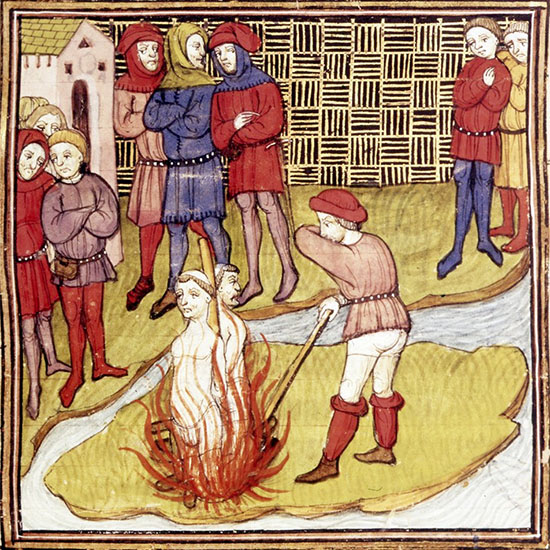 Jacques de Molay sentenced to the stake in 1314, from the Chronicle of France or of St Denis (fourteenth century). Note the shape of the island, representing the Île de la Cité (Island of the City) in the Seine, where the executions took place.
Jacques de Molay (c. 1244 – 18 March 1314) was the 22nd and last Grand Master of the Knights Templar. De Molay tried to revitalize the Order after the loss of Outremer. He rejected existing plans to merge the Templars and the Hospitallers into a single organization. During the trials, de Molay initially agreed to the charges against the Knights Templar, but later recanted his confessions. Jacques de Molay was burned at the stake in Paris in 1314.
Jacques de Molay sentenced to the stake in 1314, from the Chronicle of France or of St Denis (fourteenth century). Note the shape of the island, representing the Île de la Cité (Island of the City) in the Seine, where the executions took place.
Jacques de Molay (c. 1244 – 18 March 1314) was the 22nd and last Grand Master of the Knights Templar. De Molay tried to revitalize the Order after the loss of Outremer. He rejected existing plans to merge the Templars and the Hospitallers into a single organization. During the trials, de Molay initially agreed to the charges against the Knights Templar, but later recanted his confessions. Jacques de Molay was burned at the stake in Paris in 1314.

 Jacques de Molay sentenced to the stake in 1314, from the Chronicle of France or of St Denis (fourteenth century). Note the shape of the island, representing the Île de la Cité (Island of the City) in the Seine, where the executions took place.
Jacques de Molay sentenced to the stake in 1314, from the Chronicle of France or of St Denis (fourteenth century). Note the shape of the island, representing the Île de la Cité (Island of the City) in the Seine, where the executions took place.Pierre de Bologna
Pierre de Bologna (1270 – c.1310) was unlike most Templars, being well educated. It is possible that he received legal training in Bologna, Italy. An ordained priest, he participated in the most notable legal attempt to clear the Knights Templar of any charges. De Bologna argued that torture could not have produced credible evidence. These defense efforts were met with fierce retribution: the knights who went back on their testimonies were burnt at the stake as relapsed heretics.
Pierre de Bologna (1270 – c.1310) was unlike most Templars, being well educated. It is possible that he received legal training in Bologna, Italy. An ordained priest, he participated in the most notable legal attempt to clear the Knights Templar of any charges. De Bologna argued that torture could not have produced credible evidence. These defense efforts were met with fierce retribution: the knights who went back on their testimonies were burnt at the stake as relapsed heretics.
Esquin de Floyran
Esquin de Floyran (d. 1316) is believed to be the first person to voice his accusations against the Knights Templar, leading to their persecution by King Philip the Fair of France. There is evidence that de Floyran, a renegade Templar, held a grudge against the Order, having been punished by the Grand Master.
Esquin de Floyran (d. 1316) is believed to be the first person to voice his accusations against the Knights Templar, leading to their persecution by King Philip the Fair of France. There is evidence that de Floyran, a renegade Templar, held a grudge against the Order, having been punished by the Grand Master.
Hugues de Pairaud
Hugues de Pairaud (b. 1244) – Jacques de Molay’s deputy and Visitor of the Temple in France and Poitou. Unlike de Molay and de Charney, Hugues never recanted his testimonies and most likely remained incarcerated for the rest of his life. Hugues de Pairaud was still alive in 1321, when he was interrogated regarding the whereabouts of the Templar treasures.
Hugues de Pairaud (b. 1244) – Jacques de Molay’s deputy and Visitor of the Temple in France and Poitou. Unlike de Molay and de Charney, Hugues never recanted his testimonies and most likely remained incarcerated for the rest of his life. Hugues de Pairaud was still alive in 1321, when he was interrogated regarding the whereabouts of the Templar treasures.
Gerard de Villiers
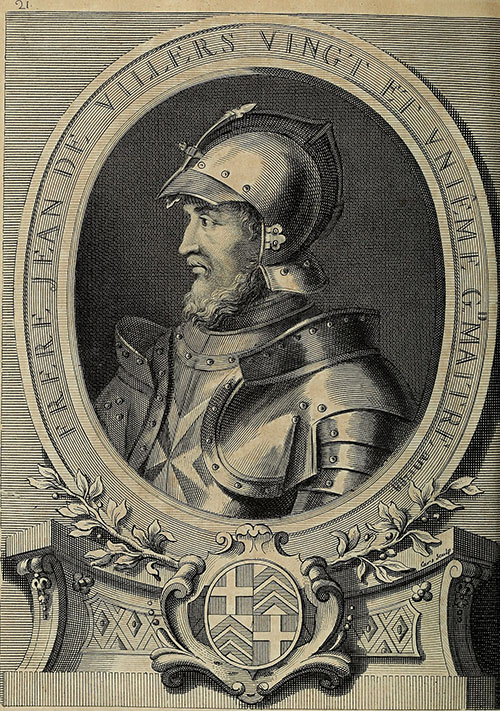 Gerard de Villiers
Gerard de Villiers – Preceptor of France, highest ranked officer to be documented as having escaped the persecution of King Philip IV.
Gerard de Villiers
Gerard de Villiers – Preceptor of France, highest ranked officer to be documented as having escaped the persecution of King Philip IV.
Nothing is known about his origin, but he is often confused with another Gerard de Villiers, who died in 1273.
It is not known the time and age when Gerard de Villiers joined the Order but probably it happened not later than 1295. In 1297 he became lieutenant of the Master of France. In 1300 Villiers became the Master of France and started a very prolific administrative activity. With the same energy he took up the economic issues, for except being a Master of France he also remained preceptor of the largest Order’s bailliages. The last mention of the Master Gerard de Villiers dates from the February 1307, later, after the arrests, the Templars held in Paris forwarded a petition to be allowed to meet the highest Order’s officials: the Grand Master Jacques de Molay and the Master of France Hugues de Pairaud. But what has happened to Villiers? If he was displaced, then what for? And if he was already dead by that time, why is it stated that he fled, perhaps with the mythical Templar Treasure?
 Gerard de Villiers
Gerard de VilliersNothing is known about his origin, but he is often confused with another Gerard de Villiers, who died in 1273.
It is not known the time and age when Gerard de Villiers joined the Order but probably it happened not later than 1295. In 1297 he became lieutenant of the Master of France. In 1300 Villiers became the Master of France and started a very prolific administrative activity. With the same energy he took up the economic issues, for except being a Master of France he also remained preceptor of the largest Order’s bailliages. The last mention of the Master Gerard de Villiers dates from the February 1307, later, after the arrests, the Templars held in Paris forwarded a petition to be allowed to meet the highest Order’s officials: the Grand Master Jacques de Molay and the Master of France Hugues de Pairaud. But what has happened to Villiers? If he was displaced, then what for? And if he was already dead by that time, why is it stated that he fled, perhaps with the mythical Templar Treasure?
Johannes Marcus Larmenius
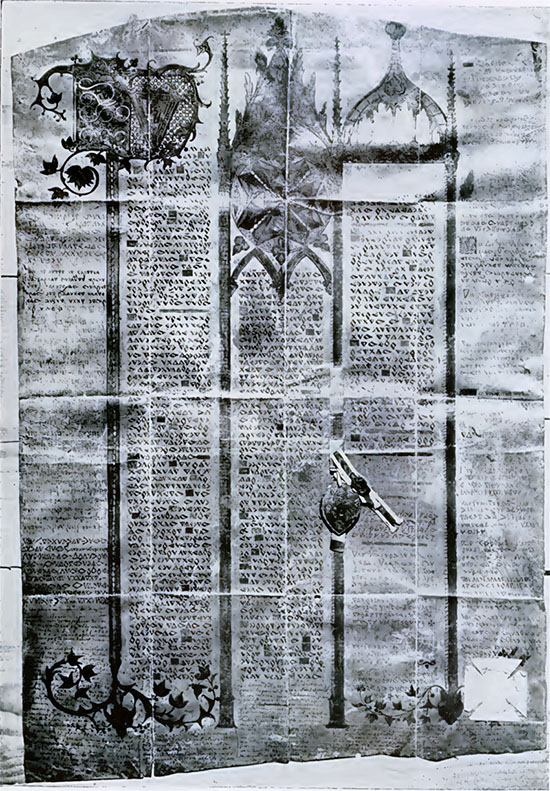 The Larmenius Charter
There is not yet conclusive evidence that Johannes existed, he is only written about much later after his time.
The Larmenius Charter
There is not yet conclusive evidence that Johannes existed, he is only written about much later after his time.
If he was indeed a real person, he was the second in charge under De Molay. He was the Palestinian-born Christian and Knight Templar Seneschal, Johannes Marcus (French: Jean-Marc) Larmenius.
At the time of De Molay’s death, Larmenius was fairly aged himself and was holding the last of the remaining Templar Order together on Cyprus. To this figure of Johannes Marcus Larmenius, is added the controversial story of the ‘Larmenius Charter’.
Created in 1324 it details the transfer of leadership after the death of De Molay, and lists the 22 successive Grand Masters of the Order, ending in 1804. Its authenticity is questioned by various scholars and researchers, but the document is held in Mark Masons Hall.
 The Larmenius Charter
The Larmenius CharterIf he was indeed a real person, he was the second in charge under De Molay. He was the Palestinian-born Christian and Knight Templar Seneschal, Johannes Marcus (French: Jean-Marc) Larmenius.
At the time of De Molay’s death, Larmenius was fairly aged himself and was holding the last of the remaining Templar Order together on Cyprus. To this figure of Johannes Marcus Larmenius, is added the controversial story of the ‘Larmenius Charter’.
Created in 1324 it details the transfer of leadership after the death of De Molay, and lists the 22 successive Grand Masters of the Order, ending in 1804. Its authenticity is questioned by various scholars and researchers, but the document is held in Mark Masons Hall.
< back